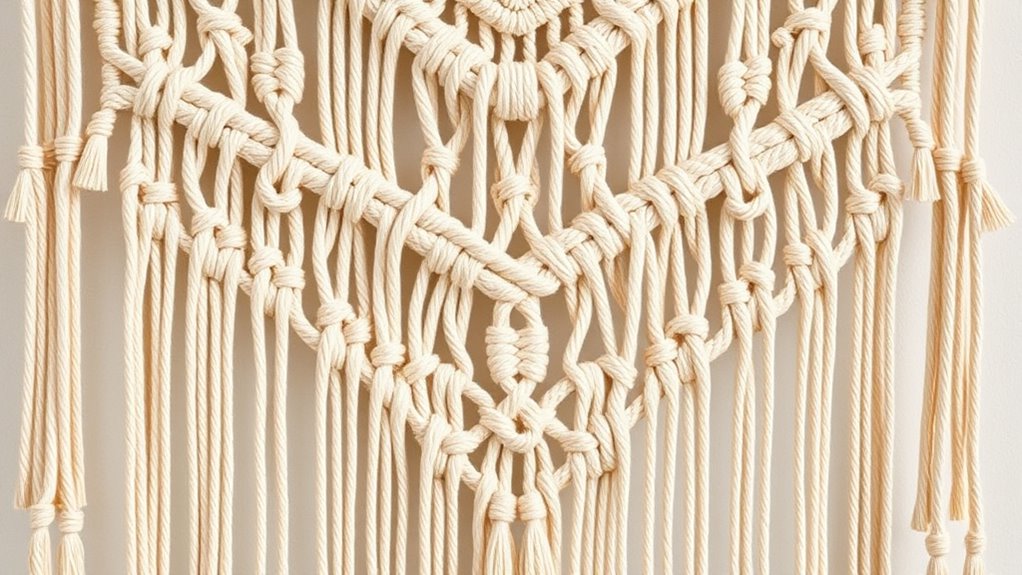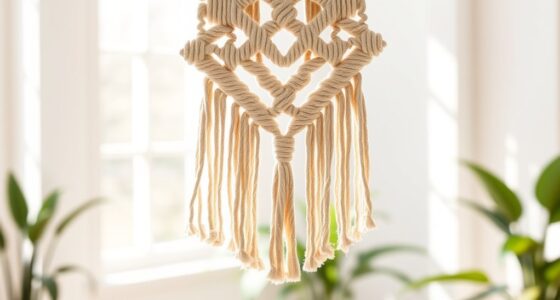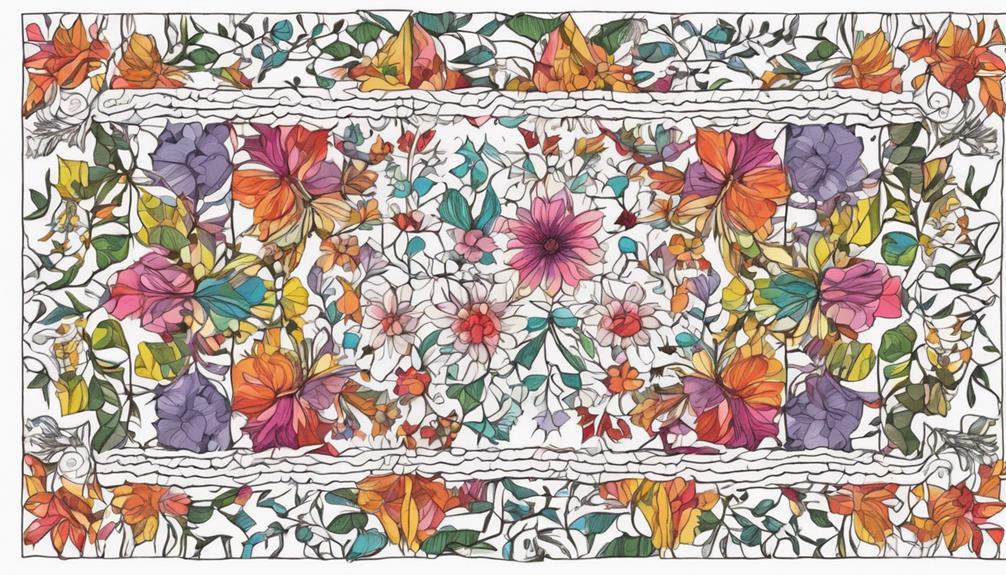To craft stunning macramé wall art, start by mastering essential knot techniques like square and half hitch knots, which form the foundation for intricate designs. Experiment with different fiber textures, such as soft cotton cords or rough jute, to add visual interest and tactile appeal. Combine various textures and knot styles to create layered, dynamic pieces that suit your decor style. If you keep exploring, you’ll discover even more ways to personalize your knot designs and enhance your craftsmanship.
Key Takeaways
- Master basic knots like square and half hitch to create diverse decorative patterns in macramé wall art.
- Experiment with different fiber textures (cotton, jute, synthetic) to add visual interest and tactile variety.
- Combine various knot techniques and textures for layered, three-dimensional designs.
- Use contrasting fiber textures and knot sizes to enhance visual complexity and artistic expression.
- Choose fibers and knot styles that align with your desired aesthetic, whether bohemian, rustic, or modern.

Macramé wall art has become a popular way to add texture and personality to any space. When you start exploring this craft, you’ll discover how the choice of fiber textures can dramatically influence the overall look and feel of your piece. From soft cotton cords to rougher jute or even synthetic fibers, each material creates a different visual and tactile effect. Soft fibers lend a delicate, airy quality, perfect for bohemian or cozy decor, while thicker, rougher fibers add a rustic or industrial vibe. Your selection of fiber textures allows you to customize your wall art to match your aesthetic, making each piece uniquely yours.
Choosing different fiber textures transforms your macramé wall art’s look and feel.
As you plunge into creating your knot designs, you’ll quickly realize that mastering knot techniques is essential. These techniques are the building blocks of all macramé, and learning them opens a world of endless possibilities for intricate patterns and textures. Starting with basic knots like the square knot or half hitch, you can build a variety of complex designs. The way you manipulate your cords—tight or loose, symmetrical or asymmetrical—adds depth and character. Each knot technique offers a different visual effect; for example, lark’s head knots create a clean, structured look, while spiral knots introduce a swirling, dynamic element. The key is to practice consistently, so your hands become familiar with how each knot feels and looks.
When working with fiber textures, consider how different knot techniques will interact with your chosen materials. Thicker fibers may require sturdier knots to hold their shape, while finer cords can be tied more delicately for intricate patterns. Experimenting with different combinations allows you to develop your style and discover what works best for your project. You might try combining smooth cotton cords with textured jute for contrast or experimenting with different knot sizes to create a layered, three-dimensional effect. Each choice influences the overall aesthetic and helps you craft a piece that truly reflects your personality.
Incorporating a variety of fiber textures and knot techniques also adds visual interest and a tactile quality that invites viewers to touch and engage with your art. As you gain confidence, you’ll find yourself designing more complex patterns, integrating different textures, and exploring innovative knot combinations. Your wall art becomes more than a decorative piece—it becomes a reflection of your creativity and craftsmanship. Whether you’re making a simple hanging or an elaborate tapestry, paying attention to fiber textures and mastering knot techniques will elevate your macramé projects, turning them into stunning, personalized works of art.
Additionally, understanding how fiber textures can influence the overall aesthetic will help you better select materials suited to your design goals and enhance the visual harmony of your piece.
Frequently Asked Questions
What Types of Cords Are Best for Beginners?
For beginners, the best cords are those with flexible fiber options like cotton or jute because they’re easy to handle and knot. Aim for medium thickness considerations, around 3-4mm, to make your knots more manageable without sacrificing visual appeal. These fiber options and thickness considerations help you get comfortable with knotting techniques, ensuring a smoother crafting experience and beautiful results in your wall art projects.
How Do I Clean and Maintain Macramé Wall Art?
You should regularly dust your macramé wall art with a soft brush or vacuum using a gentle attachment to keep it looking fresh. For deeper cleaning, spot clean with a damp cloth and mild detergent, avoiding harsh chemicals that could damage the fabric. To preserve its appearance, keep it away from direct sunlight and humidity. Proper cleaning methods help maintain the vibrant look and extend the lifespan of your decorative knot design.
Can Macramé Wall Art Be Customized for Specific Spaces?
Yes, you can customize macramé wall art for specific spaces. You’ll want to work with a designer to create a custom design that fits your style and space. Consider color coordination to match your decor, and choose the right size and knot patterns for the room’s vibe. Customization allows you to make your wall art a seamless part of your home’s aesthetic, reflecting your personal taste.
What Are the Common Mistakes to Avoid in Knotting?
To avoid knotting pitfalls and tension issues, pay attention to your tension as you work. Avoid pulling knots too tight or too loose, which can distort your design. Keep your knots even and consistent to maintain symmetry. Don’t rush the process—take your time to make sure each knot is secure. Practice different knotting techniques to improve your control, and regularly check your work for any uneven tension or slip-ups.
How Long Does It Typically Take to Complete a Piece?
It usually takes anywhere from a few hours to several days to complete a macramé wall art piece, depending on your skill level and the complexity of the design. If you’re a beginner, expect to spend more time learning and practicing knots. As you gain experience, your speed improves. For intricate patterns, allocate extra time for precision. Ultimately, your time estimation varies based on your comfort with knotting techniques.
Conclusion
Now that you’ve mastered the art of macramé wall art, you can effortlessly transform any space into a sanctuary of style. With each knot, you add a personal touch that’s truly timeless—like a vintage novel in a modern library. Don’t be afraid to experiment with different patterns and textures; after all, creativity is your most valuable tool. Before long, your handcrafted masterpiece will become a cherished focal point, proving that beauty truly lies in the details.










